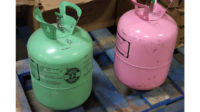general manager and head of product
Oxbox, a Trane brand
Over the past few years, the AIM Act has been an ongoing topic of discussion in the industry. As the Environmental Protection Agency (EPA) announced the most recent ruling, brands have realized that the need for planning and preparation is crucial for a smooth refrigerant transition.
To successfully navigate the transition, contractors and distributors should review their inventory, think about complete systems, and consider what impact the ruling will have on their customers’ behavior.
Managing Inventory
To prepare for this upcoming change, distributors must ask themselves one critical question: “How am I going to manage my inventory effectively through the A2L transition?” They must take ample time to evaluate existing inventory levels, historical sales, and projected growth, as well as their strategy on balancing both A1 and A2L refrigerants in their inventory to aid installation of R-410A components beyond 2025. Evaluation of the current state, as well as a roadmap to the future state, will be crucial in navigating this transition.
What we know is that the supply of R-410A refrigerant will be reduced over time. Contractors will be able to install split ducted system products manufactured or imported before January 1, 2025, until January 1, 2026. I recommend that distributors pulse their contractors to understand their plans for adopting the new A2L refrigerants to help minimize SKUs and simplify their current portfolio as much as possible. From our customer surveys at Oxbox, we are hearing a mix of some customers planning to switch to the new refrigerant immediately, while others are planning to wait.
Distributors need to ensure that systems are rated for the refrigerant type they use in order to comply with UL/CSA safety regulations, where the design refrigerant must be visible on the factory nameplate for both indoor and outdoor units. During this time, it will be essential to be careful with what products distributors choose to carry and how they match up with one another to reduce the risk of stranded inventory.
Distributors should work to identify high-performing products to bring maximum value to their business. They should also consider eliminating slow-moving SKUs and consolidating SKUs to allow space for the new product. Having an excessive number of SKUs could lead to inventory overstocking, increased holding costs, and market saturation. We recommend distributors also stock systems versus individual units, to ensure every piece of outdoor equipment has an indoor unit to match, readily serving the replacement market, while having some flexibility if a unit changeout is required.
Staying Educated
It is also important to understand that just because the EPA ruling allows for a longer sell-through period, it does not necessarily mean customer behavior will remain the same. For distributors, it is crucial to start learning early about the upcoming changes and creating a plan for your business. Take advantage of transitions playbooks, consistent communications, and training provided by OEMs to keep yourself — and your contractors — informed about the changes. Contractors can then position themselves as the knowledgeable, credible expert at the kitchen table — ultimately shaping consumer demand.
For those who are able to plan strategically through the transition, there may be potential opportunities to leverage the ruling to optimize margins — by plugging in R-410A products for specific markets while being ready with A2L products for the general population. By staying ahead of industry trends and regulations, you can make informed decisions and mitigate potential risks.







